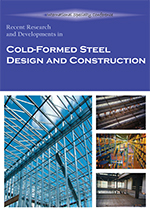Session Dates
24 Aug 2012 - 25 Aug 2012
Abstract
This paper presents the optimisation of cold-formed steel open columns using the recently developed self-shape optimisation method that aims to discover new profile shapes. The strength of the cold-formed steel sections is calculated using the Direct Strength Method, and the rules developed in the present work to automatically determine the local and distortional elastic buckling stresses from the Finite Strip and constrained Finite Strip Methods are discussed. The rules are verified against conventional and optimum sections yielded in this research, and found to accurately predict the elastic buckling stresses. The principles behind the self-shape optimisation method are summarised herein and are applied to singly-symmetric (mono-symmetric) cold-formed steel columns. “Optimum” cross-sections for simply supported columns, 0.047 inch (1.2 mm) thick, free to warp and subjected to a compressive axial load of 11,167 lb (75 kN) are presented for column lengths ranging from 39.37 inches to 98.42 inches (1,000 mm to 2,500 mm). Results show that the optimum cross-sections are found in a relatively low number of generations, and typically shape to non-conventional “bean”, “oval” or rounded “Σ” sections. The algorithm optimises for distortional and global buckling, therefore likely subjecting the cross-sections to buckling interaction.
Department(s)
Civil, Architectural and Environmental Engineering
Research Center/Lab(s)
Wei-Wen Yu Center for Cold-Formed Steel Structures
Meeting Name
21st International Specialty Conference on Cold-Formed Steel Structures
Publisher
Missouri University of Science and Technology
Document Version
Final Version
Rights
© 2012 Missouri University of Science and Technology, All rights reserved.
Document Type
Article - Conference proceedings
File Type
text
Language
English
Recommended Citation
Gilbert, Benoit P.; Savoyat, Timothee J-M; and The, Lip H., "Self-shape Optimisation of Cold-formed Steel Columns" (2012). CCFSS Proceedings of International Specialty Conference on Cold-Formed Steel Structures (1971 - 2018). 3.
https://scholarsmine.mst.edu/isccss/21iccfss/21iccfss-session2/3
Self-shape Optimisation of Cold-formed Steel Columns
This paper presents the optimisation of cold-formed steel open columns using the recently developed self-shape optimisation method that aims to discover new profile shapes. The strength of the cold-formed steel sections is calculated using the Direct Strength Method, and the rules developed in the present work to automatically determine the local and distortional elastic buckling stresses from the Finite Strip and constrained Finite Strip Methods are discussed. The rules are verified against conventional and optimum sections yielded in this research, and found to accurately predict the elastic buckling stresses. The principles behind the self-shape optimisation method are summarised herein and are applied to singly-symmetric (mono-symmetric) cold-formed steel columns. “Optimum” cross-sections for simply supported columns, 0.047 inch (1.2 mm) thick, free to warp and subjected to a compressive axial load of 11,167 lb (75 kN) are presented for column lengths ranging from 39.37 inches to 98.42 inches (1,000 mm to 2,500 mm). Results show that the optimum cross-sections are found in a relatively low number of generations, and typically shape to non-conventional “bean”, “oval” or rounded “Σ” sections. The algorithm optimises for distortional and global buckling, therefore likely subjecting the cross-sections to buckling interaction.



